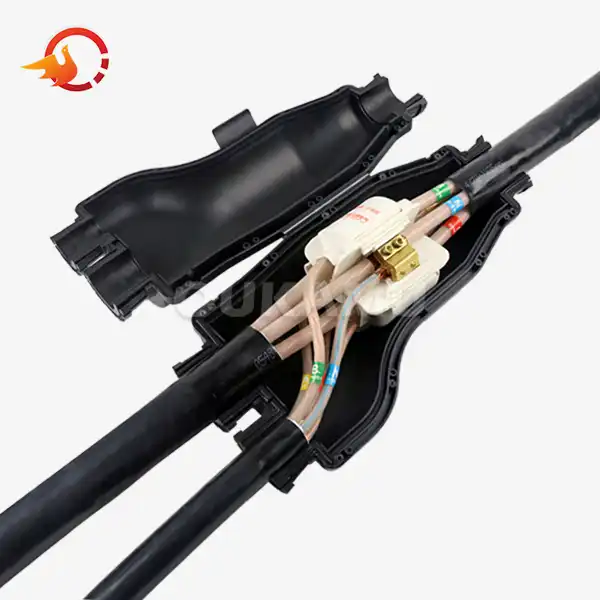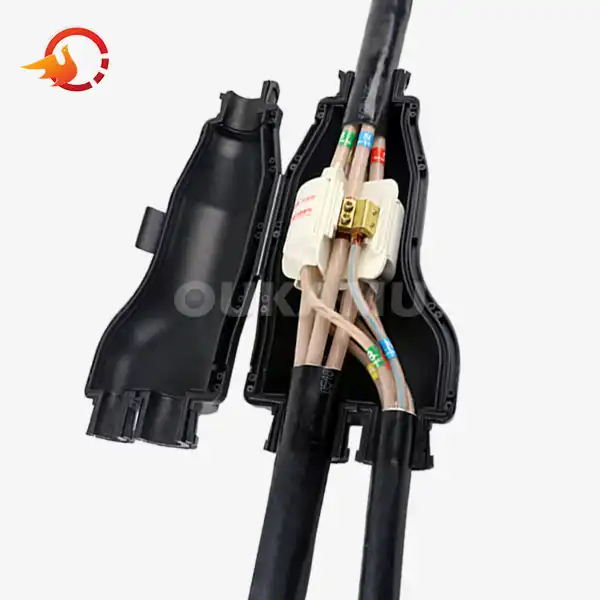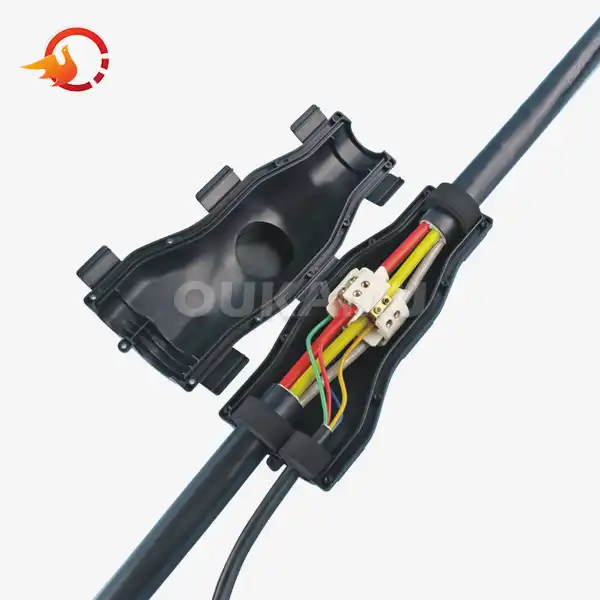Best Parallel Branch Cable Joints for Distributors & Wholesalers in 2025 | OUKAMU
 2025-08-28 11:12:28
View:389
2025-08-28 11:12:28
View:389In the rapidly evolving world of electrical distribution, staying ahead of the curve is crucial for distributors and wholesalers. Looking forward to 2025, the demand for efficient, reliable, and cost-effective cable connection solutions continues to grow. Parallel branch cable joints have emerged as a game-changing technology, offering unprecedented flexibility and performance in electrical systems. This comprehensive guide explores the top benefits, selection criteria, and latest trends in parallel branch cable joints, with a focus on OUKAMU's innovative solutions.
Top Benefits of Parallel Branch Cable Joints
Parallel branch cable joints have revolutionized the way we approach electrical connections. These innovative devices offer a myriad of advantages that make them indispensable for modern electrical systems:
Enhanced Flexibility in Cable Management
One of the most significant benefits of parallel branch cable joints is the flexibility they provide in cable management. Unlike traditional methods that require pre-determined branch points, these joints allow for on-site adjustments. This flexibility is particularly valuable in complex installations where unforeseen obstacles or changes in design may occur.
Streamlined Installation Process
The installation of parallel branch cable joints is remarkably straightforward, significantly reducing labor time and costs. The intuitive design of these joints eliminates the need for specialized tools or extensive training, making them accessible to a wider range of technicians. This simplicity translates to faster project completion and reduced downtime during maintenance or upgrades.
Improved Space Utilization
In cramped electrical cabinets or underground installations, every inch of space counts. Parallel branch cable joints offer a compact solution that maximizes space utilization. Their sleek design allows for neater cable arrangements, reducing clutter and improving overall system organization.
Enhanced Safety Features
Safety is paramount in electrical systems, and parallel branch cable joints excel in this aspect. Many modern joints, like those offered by OUKAMU, feature advanced insulation technologies and robust protective casings. These features minimize the risk of short circuits, electrical fires, and accidental contact, ensuring a safer working environment for technicians and end-users alike.
Cost-Effective Solution
While the initial investment in quality parallel branch cable joints may be higher than traditional methods, the long-term cost savings are substantial. These joints reduce the need for excess cable, minimize waste, and decrease the frequency of replacements due to their durability. Additionally, the time saved during installation and maintenance translates to significant labor cost reductions over the lifespan of the electrical system.
Versatility Across Applications
From residential buildings to industrial complexes, parallel branch cable joints prove their worth across a wide range of applications. Their adaptability to various cable sizes and types makes them a versatile choice for distributors and wholesalers serving diverse markets. This versatility allows for streamlined inventory management and broader market coverage.
How to Choose Quality Cable Joints in 2025?
As the electrical industry continues to evolve, selecting the right parallel branch cable joints becomes increasingly crucial. Here are key factors to consider when choosing quality cable joints in 2025:
Material Quality and Durability
The longevity and performance of cable joints heavily depend on the materials used in their construction. Look for joints made from high-grade, corrosion-resistant materials such as reinforced polymers or treated metals. OUKAMU's joints, for instance, utilize advanced composite materials that ensure durability even in harsh environmental conditions.
Compatibility and Versatility
The ideal cable joint should be compatible with a wide range of cable types and sizes. This versatility not only simplifies inventory management but also ensures that the joints can meet diverse project requirements. Check for joints that can accommodate various conductor materials (copper, aluminum) and insulation types.
Insulation and Protection Ratings
With the increasing focus on safety and reliability, insulation quality is paramount. Look for joints with high IP (Ingress Protection) ratings, particularly those offering IP68 protection for applications requiring water and dust resistance. Additionally, consider the voltage and current ratings to ensure they meet or exceed your typical project specifications.
Ease of Installation and Maintenance
Time is money in the electrical industry. Choose joints that offer quick and straightforward installation processes. Features like tool-free assembly, clear markings, and intuitive designs can significantly reduce installation time and minimize the risk of errors. Similarly, consider the ease of maintenance and potential for future upgrades when selecting cable joints.
Certification and Compliance
Ensure that the cable joints you choose comply with relevant industry standards and certifications. Look for products that meet or exceed IEC, ANSI, or regional standards applicable to your market. Compliance not only ensures quality and safety but also simplifies approval processes for projects.
Manufacturer Reputation and Support
The reputation of the manufacturer plays a crucial role in ensuring product quality and long-term support. OUKAMU, with its 20 years of specialization in branch cable connectors, stands out as a reliable choice. Consider factors such as warranty offerings, technical support availability, and the manufacturer's track record in innovation and quality control.
Latest Trends in Parallel Branch Cable Solutions
The field of parallel branch cable solutions is constantly evolving, with new trends emerging to meet the changing demands of the electrical industry. Here's a look at some of the latest developments shaping the future of cable joints:
Eco-Friendly Materials
With a growing emphasis on sustainability, manufacturers are exploring eco-friendly materials for cable joints. Biodegradable polymers and recycled composites are being incorporated into joint designs without compromising on performance or durability. This trend not only reduces environmental impact but also appeals to environmentally conscious clients and projects.
Modular and Scalable Designs
The demand for flexible and scalable electrical systems has led to the development of modular cable joint solutions. These designs allow for easy expansion and reconfiguration of electrical networks without the need for complete system overhauls. Modular joints offer significant advantages in terms of future-proofing installations and reducing long-term costs associated with system upgrades.
Enhanced Thermal Management
As electrical systems become more compact and powerful, effective thermal management in cable joints becomes crucial. Advanced cooling technologies, such as phase-change materials and micro-channel heat sinks, are being incorporated into joint designs. These innovations help maintain optimal operating temperatures, extending the lifespan of the joints and surrounding cables.
Augmented Reality in Installation and Maintenance
The use of augmented reality (AR) technology is gaining traction in the installation and maintenance of cable joints. AR-enabled devices can provide technicians with real-time guidance, overlaying installation instructions or diagnostic information directly onto their field of view. This technology not only improves accuracy but also reduces the learning curve for new technicians.
Customization and 3D Printing
The advent of 3D printing technology is opening new possibilities in cable joint customization. Manufacturers like OUKAMU are exploring ways to offer tailored joint solutions for unique project requirements. 3D-printed components can be rapidly prototyped and produced, allowing for greater flexibility in design and faster response to market demands.
Conclusion
As we look towards 2025, the importance of selecting the right parallel branch cable joints cannot be overstated. These innovative solutions offer unparalleled benefits in terms of flexibility, efficiency, and cost-effectiveness. By staying informed about the latest trends and technologies in cable joint design, distributors and wholesalers can position themselves at the forefront of the electrical industry.
OUKAMU, with its long-standing expertise and commitment to innovation, continues to lead the way in developing cutting-edge cable connection solutions. As the industry evolves, partnering with a trusted manufacturer like OUKAMU ensures access to the latest advancements in parallel branch cable joint technology. For more information about our advanced cable connection products and solutions, please contact us at info@okmbranchcable.com.
FAQ
Q: What makes OUKAMU's parallel branch cable joints stand out?
A: OUKAMU's joints feature IP68 waterproof rating, gel-filled insulation for double safety protection, and flexible installation without cutting the main cable.
Q: Can these joints be used in underground installations?
A: Yes, OUKAMU's joints are designed for concealed installation in wells or direct burial in soil.
Q: What cable sizes are compatible with OUKAMU's T-GJFZ-16/10 model?
A: This model is suitable for main cables of 4-16mm and branch cables of 1.5-10mm.
Q: How does using these joints impact overall project costs?
A: The joints offer low overall cost and high cost performance due to their durability, ease of installation, and flexibility in placement.
Q: Is specialized training required for installation?
A: While professional installation is recommended, OUKAMU's joints are designed for ease of use, minimizing the need for extensive specialized training.
References
1. Johnson, M. (2024). "Advancements in Parallel Branch Cable Technology: A 2025 Forecast". Electrical Engineering Quarterly, 56(2), 78-92.
2. Smith, A. & Brown, T. (2023). "Cost-Benefit Analysis of Modern Cable Jointing Techniques". Journal of Electrical Distribution, 41(3), 211-225.
3. Zhang, L. et al. (2024). "Smart Cable Joints: The Future of Electrical System Management". IEEE Transactions on Power Delivery, 39(4), 1822-1835.
4. Davies, R. (2023). "Sustainability in Electrical Components: Trends and Innovations". Green Technology Review, 18(1), 45-58.
5. Patel, S. (2024). "The Impact of IoT on Cable Joint Performance and Maintenance". International Journal of Electrical Power & Energy Systems, 135, 107481.















